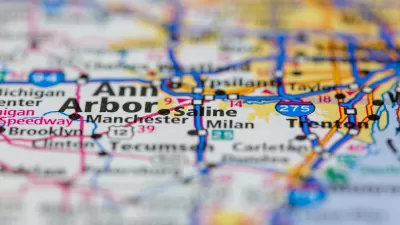States are developing a variety of mechanisms for replacing dwindling gas tax revenue, which most rely on for the majority of their transportation funding.

More states are implementing policies aimed at replacing lost revenue from gas taxes, which are bringing in less money as more electric vehicles hit the road and have “traditionally been a critical source of funding for transportation infrastructure,” according to an article by Jared Brey in Governing.
Brey notes that “A national pilot program to collect VMT fees in place of gas taxes is expected in the next few years.” Meanwhile, over half of U.S. states have some kind of fee for electric vehicles to offset the lost revenue, but a recent report from the MIT Mobility Initiative reveals that “most aren’t high enough to replace the revenue the average driver pays in state gas taxes each year.”
“The need to replace the gas tax is also a chance to build a ‘more rational transportation funding system,’ the report says — one that accounts for all the ways that cars wear on infrastructure and the environment, whether they’re electric or gas-powered.” In 2006, Oregon launched the nation’s first voluntary VMT-based fee program, which “allows drivers to opt in and pay a 1.8-cents-per-mile fee and get a credit against gas taxes paid.”
At the federal level, the Department of Transportation is tasked by the Infrastructure Investment and Jobs Act with developing a pilot program to “test the design, acceptance, implementation and financial sustainability” of VMT fees, but Garett Shrode, a policy analyst at the Eno Center for Transportation, says the department is “dragging its feet” and “should focus on simplicity, and on finding ways for federal and state VMT programs to overlap.”
FULL STORY: Clock Ticking for States to Replace Dwindling Gas Taxes

Trump Administration Could Effectively End Housing Voucher Program
Federal officials are eyeing major cuts to the Section 8 program that helps millions of low-income households pay rent.

Planetizen Federal Action Tracker
A weekly monitor of how Trump’s orders and actions are impacting planners and planning in America.

Ken Jennings Launches Transit Web Series
The Jeopardy champ wants you to ride public transit.

Washington Legislature Passes Rent Increase Cap
A bill that caps rent increases at 7 percent plus inflation is headed to the governor’s desk.

From Planning to Action: How LA County Is Rethinking Climate Resilience
Chief Sustainability Officer Rita Kampalath outlines the County’s shift from planning to implementation in its climate resilience efforts, emphasizing cross-departmental coordination, updated recovery strategies, and the need for flexible funding.

New Mexico Aging Department Commits to Helping Seniors Age ‘In Place’ and ‘Autonomously’ in New Draft Plan
As New Mexico’s population of seniors continues to grow, the state’s aging department is proposing expanded initiatives to help seniors maintain their autonomy while also supporting family caregivers.
Urban Design for Planners 1: Software Tools
This six-course series explores essential urban design concepts using open source software and equips planners with the tools they need to participate fully in the urban design process.
Planning for Universal Design
Learn the tools for implementing Universal Design in planning regulations.
Heyer Gruel & Associates PA
Ada County Highway District
Institute for Housing and Urban Development Studies (IHS)
City of Grandview
Harvard GSD Executive Education
Toledo-Lucas County Plan Commissions
Salt Lake City
NYU Wagner Graduate School of Public Service





























